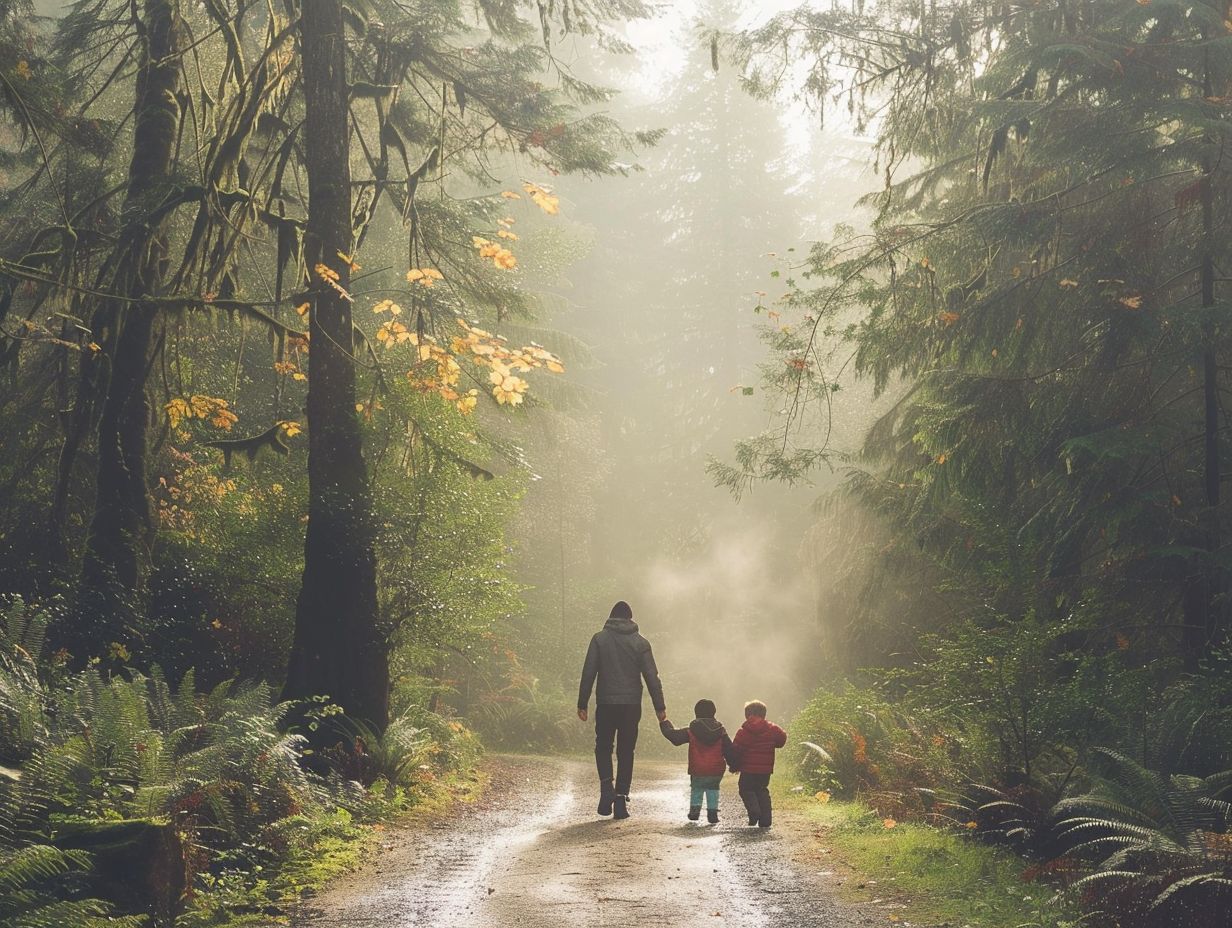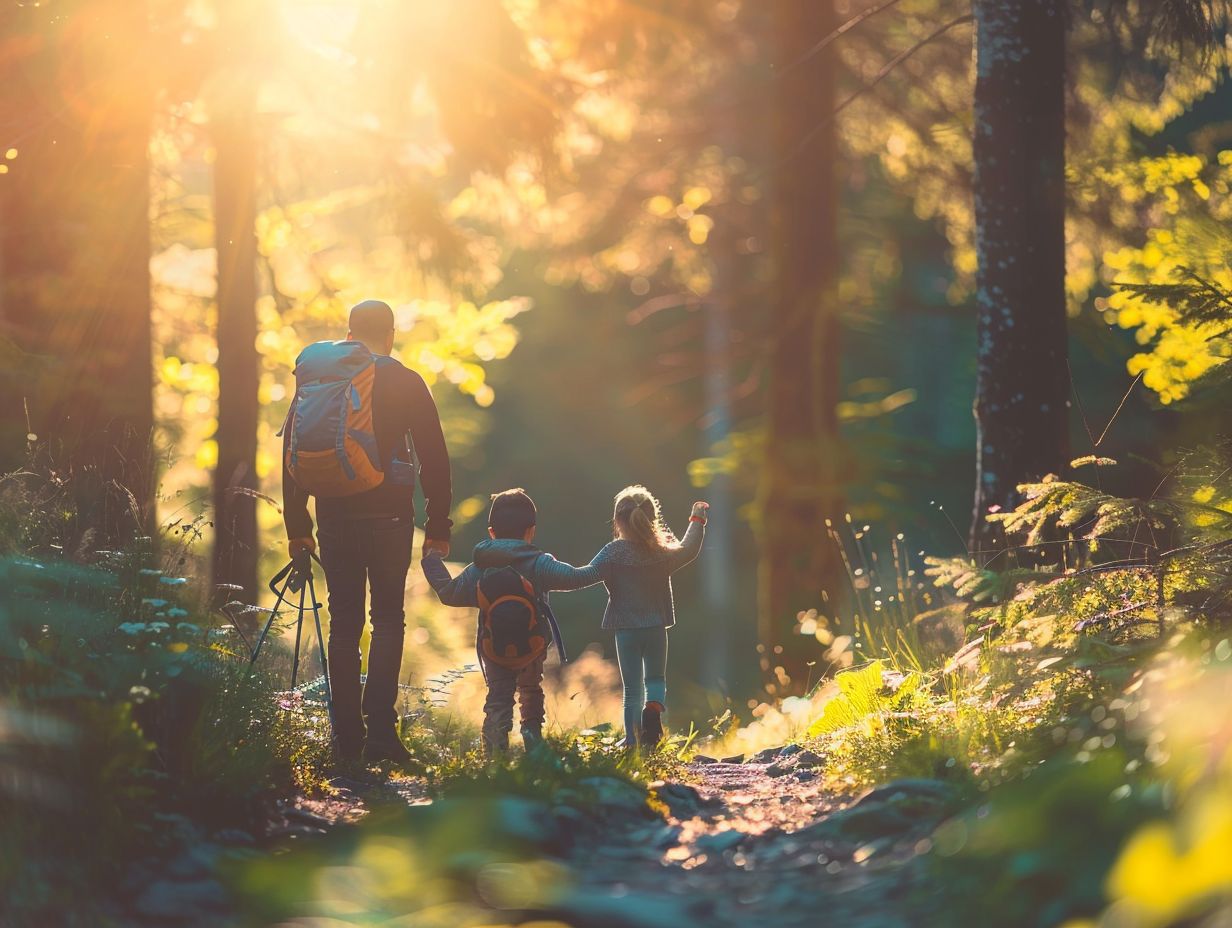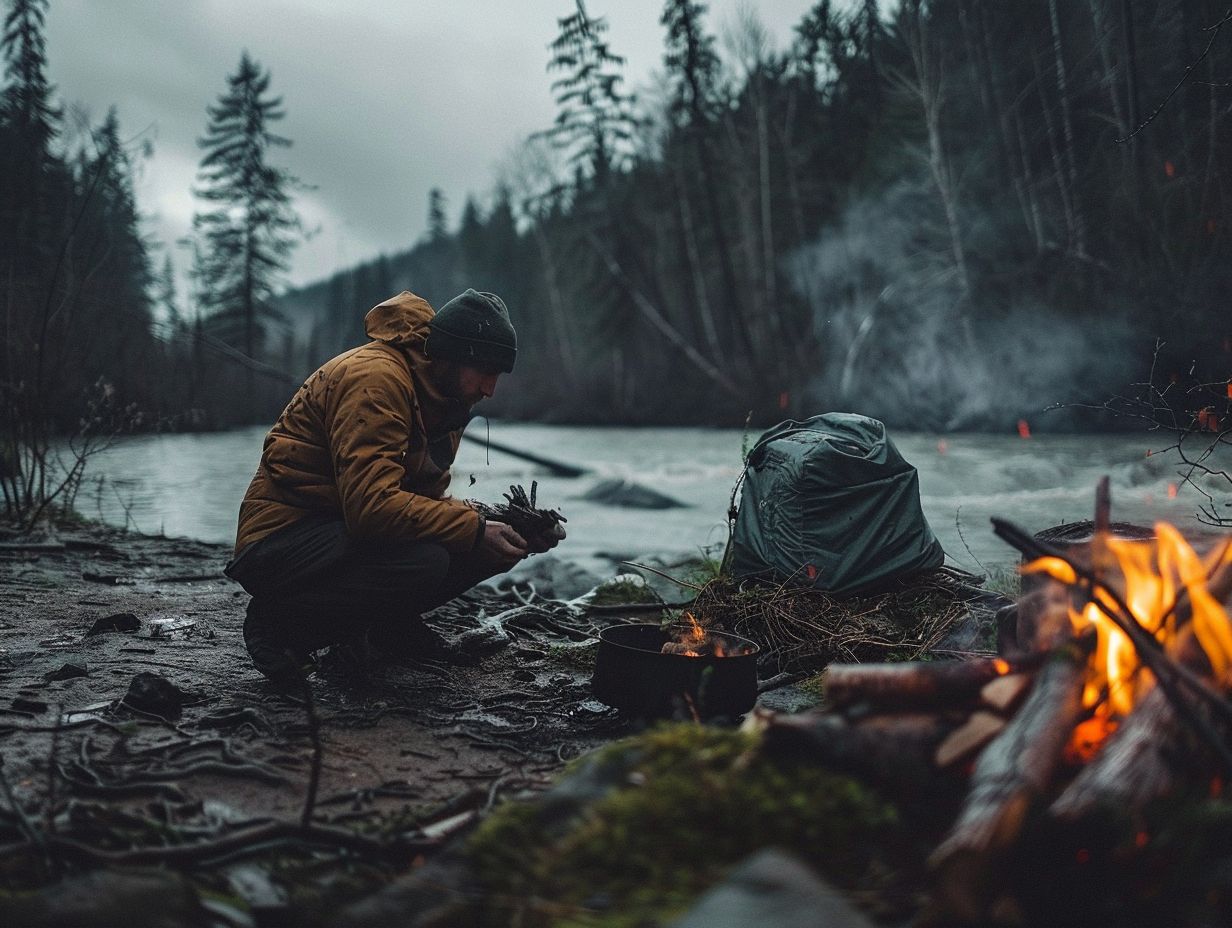Are you seeking ways to enhance outdoor adventures with your children for a more fulfilling experience? Your search ends here!
This article delves into 15 practical tips aimed at maximising the enjoyment and educational value of outdoor activities when engaging with kids.
Covering aspects from safety planning in advance to fostering exploration and learning, we have all your bases covered. Uncover the advantages that outdoor activities offer children, gather ideas for family-friendly adventures, and learn strategies for ensuring the safety and engagement of your little ones in natural settings.
Prepare to embark on a shared journey of outdoor exploration and discovery!
Key Takeaways:

- Plan ahead to ensure safety for your family in the outdoors.
- Choose age-appropriate activities to keep kids engaged and interested.
- Pack appropriate gear and snacks to make the experience comfortable and enjoyable for everyone.
Choose Kid-Friendly Activities
Selecting child-friendly activities is crucial to ensuring that children have a positive and enjoyable experience in the outdoors. Adapting activities to their interests and abilities can help nurture a love for nature and outdoor exploration.
When planning engaging outdoor activities designed for children, consider nature scavenger hunts where they can search for specific items such as pine cones, feathers, or different types of leaves. Easy walks along nature trails not only offer physical exercise but also enable children to discover various plants and animals, sparking curiosity and a sense of adventure.
Activities like wildlife watching, such as bird-watching or identifying insects, can help children establish a connection with the natural world and develop an appreciation for its diverse beauty.
Interactive nature crafts, such as making leaf rubbings or painting rocks, provide a hands-on and creative way for children to engage with their environment, enhancing their creativity and fostering a deeper appreciation for nature.
Pack Appropriate Gear
Having the right gear is essential for a successful outdoor adventure with kids. When preparing for the trip, ensure to pack appropriately, including essential items such as rucksacks, first aid supplies, and suitable clothing to guarantee comfort and safety for the whole family.
For hiking in national parks, it is crucial to have sturdy walking boots for both you and the children, along with lightweight rucksacks containing an ample supply of water and snacks.
Camping in the wilderness demands durable tents that can endure the elements, warm sleeping bags, and portable cooking equipment.
When selecting gear for children, prioritize lightweight options that fit properly and are easy for them to carry. Consider including items like torches or lanterns to provide illumination during evenings spent in the great outdoors.
Consider the Weather and Location
Before heading out on any outdoor expedition, it is vital for you to consider the weather conditions and the specific location where your adventure will take place. Understanding the terrain, climate, and potential challenges can help you prepare effectively and anticipate any risks.
In mountainous regions, despite the breathtaking views and sense of adventure, weather conditions can change rapidly, with temperatures dropping significantly at higher altitudes. To navigate safely, make sure to pack essential gear such as layers, waterproof clothing, and sturdy footwear.
When exploring urban parks, be aware that sudden rain showers can enhance the greenery but also present a challenge. It is advisable to bring along a small umbrella or raincoat to be prepared for unexpected downpours.
For a more controlled environment, indoor nature centres can provide a refuge from extreme weather conditions and are perfect for wet days. These centres offer intriguing displays and educational opportunities, making them an excellent choice for a day out.
Involve Kids in the Planning Process
Engaging children in the planning process of outdoor activities can foster a sense of ownership and excitement for the adventure ahead. When children are given the opportunity to contribute their ideas and preferences, they feel enableed and may develop a greater sense of responsibility and pride in the final plan.
This level of involvement not only promotes teamwork within the family but also encourages positive reinforcement as children witness their input being valued and put into action.
To incorporate their ideas effectively, parents can organise brainstorming sessions where each family member has the chance to share their suggestions. Another approach is to create a vision board or collage together, visually representing each family member’s desires and expectations for the trip.
Bring Snacks and Water
Ensuring that your children stay hydrated and energised during outdoor adventures is crucial for their well-being and overall enjoyment. It is important to pack nutritious snacks and an adequate water supply to keep your kids fuelled and hydrated throughout the journey.
In terms of snacks, consider opting for fruits such as apples, oranges, or grapes. These fruits are not only easy to pack but also provide a natural source of energy. Nuts and seeds are also great snack options as they offer protein and healthy fats, providing sustained energy for your children.
You may want to prepare homemade trail mix with a combination of dried fruits and nuts, creating a delicious and nutritious snack that the entire family can enjoy during breaks in the adventure.
Remember to emphasise the importance of staying hydrated by encouraging your children to sip water frequently. Additionally, you may want to consider bringing electrolyte-rich drinks to ensure proper replenishment throughout the outdoor excursion.
Teach Leave No Trace Principles

Instilling Leave No Trace principles in children can promote environmental stewardship and respect for wildlife and their habitats. Teaching children to minimise their impact on nature while enjoying outdoor activities helps preserve natural spaces for future generations.
Encouraging children to follow practices such as packing out rubbish, staying on designated paths, and leaving natural objects undisturbed can instil a sense of responsibility towards the environment. By practising Leave No Trace, children learn the importance of wildlife protection, such as observing animals from a distance and refraining from feeding them.
Engaging in activities like tree identification or bird watching can foster a deeper connection with nature while instilling the values of conservation and preservation.
Be Flexible and Patient
Flexibility and patience are key virtues when engaging in outdoor activities with children. Embrace unexpected challenges or changes in plans with a positive attitude to turn adversities into valuable learning experiences for the whole family.
Encountering unforeseen circumstances during outdoor adventures can provide unique opportunities for kids to develop resilience and problem-solving skills. By demonstrating adaptability and staying calm when faced with unexpected setbacks, you can model effective coping strategies for your children.
Turning these challenges into teachable moments not only fosters a sense of teamwork and cooperation but also helps kids understand that setbacks are a natural part of any journey. Encouraging a growth mindset and viewing obstacles as opportunities for growth can instil a sense of optimism and perseverance in your children.
Encourage Exploration and Learning
Encouraging your children to explore and learn during outdoor adventures can ignite their curiosity and cultivate an appreciation for the natural world. By providing opportunities for hands-on experiences and discovery, you can create lasting memories and nurture a passion for outdoor exploration.
Engaging in activities such as identifying different plant species, collecting rocks, or observing insect behaviour can transform learning into a fun and interactive experience for kids. Through these hands-on activities, children not only deepen their knowledge of the environment but also develop crucial skills like critical thinking and problem-solving.
Encouraging you, as parents, to participate in these adventures can further enhance the learning process. It allows you to bond with your children and create shared experiences that strengthen family connections.
Have Fun and Be Silly
When engaging in outdoor adventures with children, the focus should always be on enjoyment and embracing the lighthearted moments that arise from being silly together. By creating an atmosphere that fosters a sense of humour, you can enrich the overall experience and strengthen the bonds within your family.
It’s remarkable how simple acts of playfulness have the power to turn an ordinary day outdoors into a memorable and laughter-filled escapade. Whether you’re participating in a playful game of tag, having a silly dance-off, or just making funny faces together, these moments of silliness can lift the spirits of both children and adults.
By letting go of any inhibitions and embracing silliness, parents can establish a playful environment that cultivates creativity, spontaneity, and pure enjoyment for all participants. Remember, laughter is indeed a powerful tool, and infusing a healthy dose of silliness into outdoor activities can elevate the experience from merely enjoyable to truly unforgettable.
Take Breaks and Rest When Needed
Recognising the importance of breaks and rest periods during outdoor adventures is essential for maintaining the well-being and energy levels of children. Listening to signals of fatigue and providing adequate rest can help prevent exhaustion and ensure a positive experience for them. It is crucial to pace the activity appropriately to ensure that the adventure is enjoyable and not overwhelming.
Younger children or those less accustomed to physical exertion may require more frequent breaks to recharge and rejuvenate.
By strategically planning rest stops along the route, you can optimise the adventure for all participants. Proper pacing allows for a more fulfilling experience, with each break serving as a moment to appreciate nature and soak in the surroundings before continuing the journey.
Bring First Aid Supplies
When venturing into the outdoors with kids, it is essential to carry first aid supplies to ensure their safety. Being prepared for minor injuries or medical needs can guarantee prompt care and comfort for children during the adventure.
In your first aid kit, make sure to include must-have items such as plasters for covering cuts and scrapes, antiseptic wipes for cleaning wounds, suncream to protect their skin from sunburn, and insect repellent to keep bugs at bay.
Understanding how to correctly utilise these supplies is crucial for effectively managing emergencies. Teaching your children basic first aid skills, like cleaning and dressing a wound, can enable them to take care of themselves and others in case of minor accidents while exploring the outdoors. This knowledge can provide them with confidence and the ability to respond appropriately in unforeseen situations.
Consider Bringing a Friend or Family Member
Including a friend or family member in your outdoor adventures with children can enrich the experience by fostering camaraderie and creating shared memories. The presence of additional companions can offer valuable support and assistance, enhancing the overall enjoyment of the journey.
Involving other adults or children in these outdoor activities can establish a robust learning environment for the children. By introducing different perspectives and skill sets, the children are exposed to a variety of approaches to challenges and problemsolving.
This diversity allows for the efficient division of responsibilities, ensuring that tasks are managed effectively. Promoting group participation not only enhances social skills but also cultivates teamwork and cooperation among all participants.
Respect Wildlife and Their Habitat

Teaching children to respect wildlife and their natural habitats is essential for fostering a sense of environmental stewardship and conservation. Encouraging you to observe animals from a distance and minimise disturbances can help protect the ecosystem and its inhabitants.
By instilling a love and understanding of nature at a young age, you can grow up to be a responsible steward of the environment. Along with teaching you respect for wildlife, it is important to educate you on the impact of human actions on animal species and their habitats.
When visiting national parks or natural areas, you should be taught to follow guidelines for responsible wildlife viewing, such as not feeding animals, staying on designated paths, and avoiding loud noises that could startle or stress the wildlife.
Document the Experience
Capturing and documenting outdoor experiences with your children can create lasting memories and opportunities for reflection.
Whether through photos, journals, or art, preserving the moments shared in nature can enrich your overall family adventure. This documentation not only serves as a lovely keepsake for your family but also allows your children to revisit and cherish those experiences as they grow older.
Sharing these memories with loved ones and friends can also inspire others to get outside and create their own nature stories. By encouraging storytelling and creativity, families can deepen their connection to the natural world and strengthen bonds while fostering a love for the great outdoors.
How Can Outdoor Activities Benefit Children?
Engaging in outdoor activities offers numerous benefits for children, ranging from physical health improvements to enhanced cognitive development. Exploring nature, learning new skills, and experiencing the outdoors can positively impact a child’s overall well-being and growth.
Spending time outdoors encourages children to be physically active, which is essential for their overall growth and development. Research has shown that exposure to nature can reduce stress, anxiety, and symptoms of ADHD in children.
Outdoor play fosters creativity, as it allows children to use their imagination in an unrestricted environment. Through interactions with nature, kids develop empathy, respect for the environment, and a sense of responsibility towards the world they inhabit.
What Are Some Examples of Kid-Friendly Outdoor Activities?
Child-friendly outdoor activities encompass a wide range of options that cater to different interests and age groups. From nature walks and picnics to interactive wildlife exploration and outdoor games, these activities aim to engage children in fun and enriching experiences in the great outdoors.
Whether your child enjoys high-energy physical activities or prefers more educational pursuits, there are plenty of options to choose from. For physical exertion, activities like scavenger hunts, obstacle courses, and cycling provide a great workout while keeping them entertained.
On the educational front, gardening, bird-watching, and cloud-gazing spark curiosity and offer learning opportunities about nature and the environment. For interactive play, consider setting up a nature-themed obstacle course, creating outdoor art with natural materials, or organising a mini treasure hunt to encourage teamwork and creativity.
How Can Parents Ensure Their Children’s Safety in the Outdoors?
Ensuring children’s safety in the outdoors requires proactive planning and the development of essential safety skills. As a parent, you can safeguard your children by teaching them about potential risks, preparing emergency protocols, and equipping them with the necessary safety gear for outdoor adventures.
Effective parental supervision plays a crucial role in ensuring that children stay safe while exploring the outdoors. As a responsible parent, you should establish clear boundaries and rules, such as staying within specified areas and checking in at regular intervals.
Communicating openly with your children about safety measures and the reasons behind them is also key. Encouraging kids to ask questions and express any concerns fosters a culture of transparency and understanding.
Plus supervision strategies, you should involve your children in creating emergency response plans, practicing what to do in different scenarios, and teaching basic first aid skills. By taking these steps, you can help ensure your children’s safety during outdoor activities.
What Are Some Tips for Keeping Kids Engaged and Interested in Nature?
To keep children engaged and interested in nature, you need to incorporate interactive and stimulating activities that cater to their curiosity and sense of wonder. Providing opportunities for exploration, hands-on learning, and positive reinforcement can help nurture a lasting love for the natural world.
Encouraging children to participate in nature-themed games like scavenger hunts, plant identification challenges, and bird watching can make outdoor experiences more exciting and educational. Incorporating sensory activities, such as listening to different bird songs or feeling different types of leaves, can enhance their connection with the environment.
Wildlife observation challenges, such as tracking animal footprints or observing insect habitats, can spark curiosity and appreciation for the biodiversity around them. Using positive reinforcement, like praising their observations or discoveries, helps sustain their enthusiasm for exploring nature.
How Can Parents Teach Their Children About Environmental Stewardship?
You play a crucial role in teaching your children about environmental stewardship and instilling a sense of responsibility towards wildlife and natural habitats. By modelling respectful behaviour, educating your kids about ecosystems, and engaging in conservation efforts, you can enable your children to become environmental advocates.
Encourage your children to participate in hands-on activities such as planting trees, picking up litter, or creating bird feeders to make environmental concepts tangible and fun. Discuss the importance of reducing waste, recycling materials, and conserving energy in daily routines to help your children understand the impact of their actions on the environment.
Family outings to nature reserves, botanical gardens, or wildlife sanctuaries can further enrich your children’s understanding of the importance of habitat preservation and wildlife protection.
Frequently Asked Questions

What are some important safety tips to keep in mind when enjoying the great outdoors with kids?
It’s important to always stay aware of your surroundings and keep an eye on children at all times. Make sure to bring plenty of water, sunscreen, and insect repellent. It’s also a good idea to have a first aid kit handy and to teach kids about potential dangers like poison ivy or wild animals.
How can I keep my kids entertained while spending time outdoors?
There are plenty of fun and engaging activities to do with kids while enjoying the great outdoors. You can go on a nature scavenger hunt, play outdoor games like tag or hide and seek, or have a picnic in a scenic spot. You can also bring along some outdoor toys like balls, frisbees, or kites.
Is it important to teach kids about respecting nature while spending time outdoors?
Absolutely! It’s crucial to instil a sense of respect and appreciation for the natural world in children. Teach them to never litter, to stay on designated trails, and to not disturb plants or animals. Encourage them to take care of the environment and leave it as they found it.
How can I make sure my kids are comfortable while spending time outdoors?
Dressing appropriately is key to ensuring your kids are comfortable while spending time outdoors. Make sure they are wearing lightweight, breathable clothing and comfortable shoes. It’s also important to pack extra layers in case the weather changes. Don’t forget to bring hats and sunglasses for sun protection.
Can I bring my very young children outdoors?
Yes, even very young children can enjoy spending time outdoors! Just make sure to take extra precautions, such as using a baby carrier or stroller on rough terrain, providing plenty of shade, and bringing along plenty of snacks and drinks. Also, be mindful of nap and feeding schedules.
Are there any other tips for enjoying the great outdoors with kids?
One important tip is to plan ahead and do your research. Look for family-friendly trails or parks, and make sure to check the weather before heading out. It’s also a good idea to involve your kids in the planning process and let them choose some activities they would like to do. Most importantly, have fun and enjoy the time spent together in nature!



